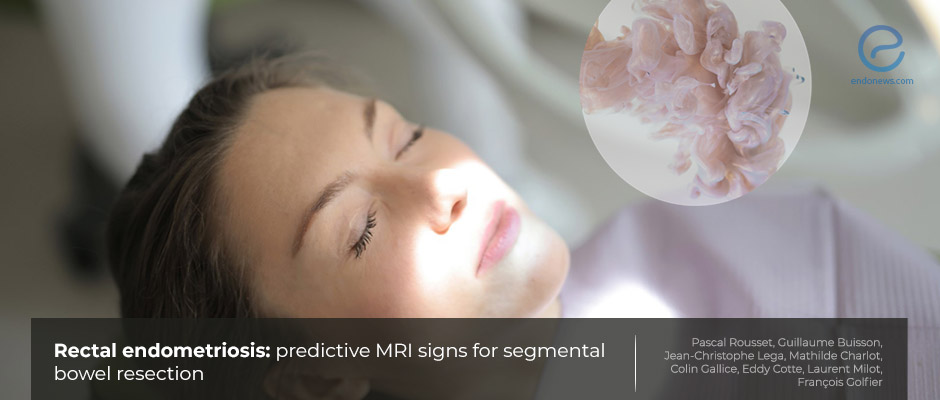Segmental bowel resection could be predicted using MRI in patients with rectal endometriosis
Oct 28, 2020
Preoperative MRI assessment of rectal endometriosis helps to plan the most appropriate surgical approach and providing accurate counseling
Key Points
Highlights:
- MRI helps to decide which method to use, including shaving, disc excision, or segmental resection, for the surgical treatment of rectal endometriosis.
Importance:
- The women with rectal endometriosis should be assessed with MRI which has a value both for the preoperative diagnosis of rectal endometriosis and preoperative risk evaluation of performing segmental resection.
What’s done here?
- This retrospective study was conducted in a tertiary center included patients diagnosed with deep infiltrating endometriosis who were assessed with MRI.
- Clinical findings, physical examinations, imaging evaluation, and surgical findings determined the surgical approach, shaving, and/or segmental resection.
- Shaving was performed for wide but not long nodules, and a transverse suture was used for longer lesions. Patients with simultaneously wide and long folded lesions, rectal stenosis, large deep submucosal protrusion or mucosal involvement at rectal examination underwent segmental resection.
- Seven rectal signs including lesion length, the transverse axis, thickness, circumference, the presence of a convex base, submucosal edema, and hyperintense cystic areas and four pararectal signs (posterior vaginal fornix, parametrial, ureteral, sacro-rectogenital septum involvement) were evaluated.
Key results:
- Sixty-one women met the eligibility criteria (shaving: 29, segmental resection:32). During the follow-up period (mean: 47months), suspicious rectal recurrence developed in 6 patients.
- The cut-off values to discriminate best performance were: length ≥ 32 mm, thickness ≥ 14 mm, transversal axis ≥ 22 mm, and circumference ≥ 3 radii.
- All MRI rectal signs were found to have a significant association with an increased probability of segmental resection.
- The independent predictors of segmental resection were thickness ≥ 14 mm, and circumference ≥ 3 radii.
- The involvement of the posterior part of the sacro-recto-genital septum had a strong association with an increased probability of segmental resection.
Strengths and Limitations
- Retrospective nature of MRI signs, relatively small number of patients, surgeons having information about MRI results are the main limitations.
- The comparison was only done between the MRI pararectal signs and surgical reports, the efficacy parameters of the MRI pararectal signs were not calculated.
- The inter-observer agreement for the evaluation of MRI findings was not investigated.
Lay Summary
The rectum and recto-sigmoid junction are the preferential localisations of bowel endometriosis. The three main surgical approaches are shaving, disc excision, and segmental resection. It is very important to decide the most appropriate surgical method preoperatively and to plan accordingly.
Currently, there is no international consensus on the surgical approach for lesions involving the rectum and recto-sigmoid junction, however, a superficial infiltration is generally managed by rectal shaving but, for deeper or larger infiltrations, the radical segmental resection approach with a high rate of morbidity cannot be avoided. Clinical findings, physical examination, and imaging evaluation including transvaginal ultrasound and magnetic resonance imaging could be used to determine the rectal location of endometriosis.
Rousset et al., from France, published a report entitled “Rectal endometriosis: predictive MRI signs for segmental bowel resection” in the journal "European Radiology". The authors aimed to define the feasibility of MRI for the preoperative prediction of segmental resection necessity in patients with rectal endometriosis. The authors used seven rectal signs including the lesion length, transverse axis, thickness, circumference, the presence of a convex base, submucosal edema, hyperintense cystic areas, and four pararectal signs including posterior vaginal fornix, parametrial, ureteral and sacro-recto-genital septum involvement.
The authors found that all the seven rectal MRI signs had a significant association with an increased probability of segmental resection, but nodular thickness ≥ 14 mm and a circumference ≥ 38% were found to be the most predictive for segmental resection. Among the pararectal MRI signs, only the involvement of the posterior part of the sacro-recto-genital septum had a strong association with an increased probability of segmental resection.
“MRI analysis of rectal endometriosis, taking into account rectal and pararectal signs, may assist surgeons in the decision-making process, in counseling patients regarding the surgical procedure and adequately allocating resources.” the authors added.
Research Source: https://pubmed.ncbi.nlm.nih.gov/32851441/
endometriosis rectum digestive system surgical procedures magnetic resonance imaging segmental resection nodular thickness

